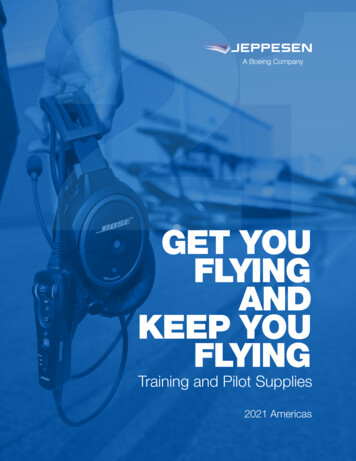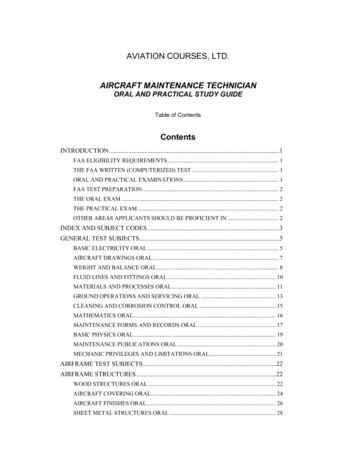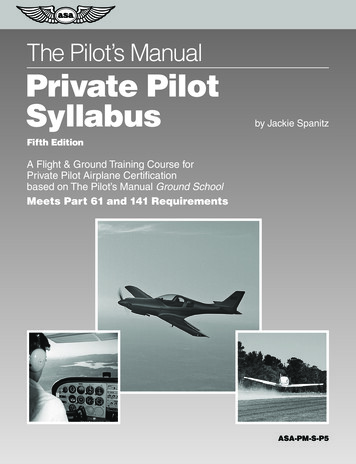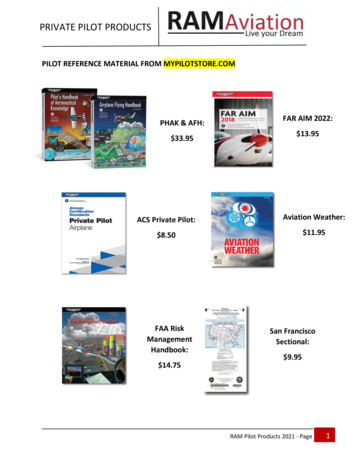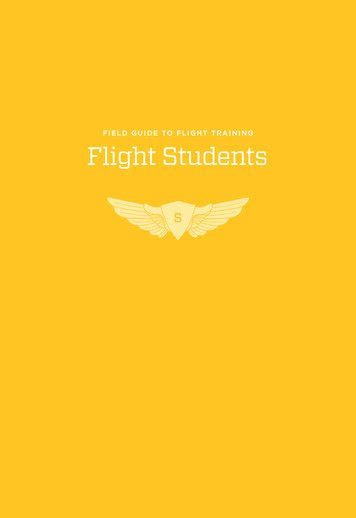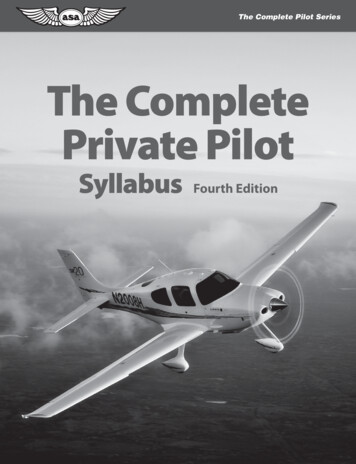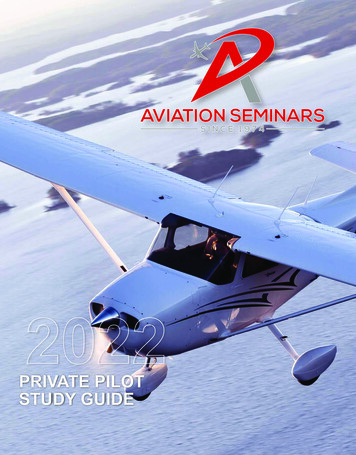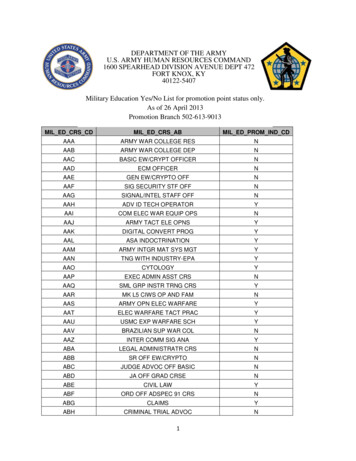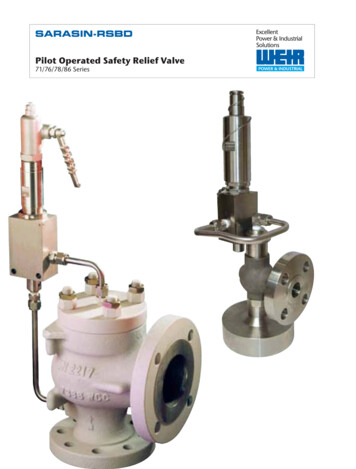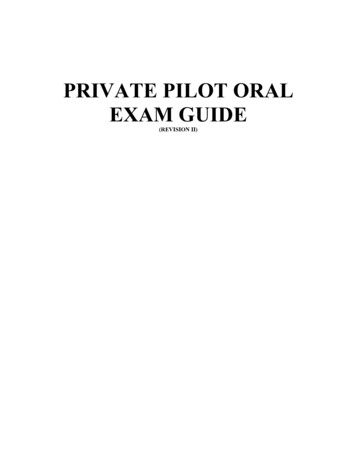
Transcription
PRIVATE PILOT ORALEXAM GUIDE(REVISION II)
REFERENCESFAR/AIMPHAKAC 00-45GPOHRECOMMENDED READINGSAC 00-6A
Private Pilot Course: Oral ExamCertificates and Documents What documents must you have on your person? (61.3)Pilot certificate, medical certificate, and government issued photo ID What privileges and limitations apply to private pilot? (61.113)Privileges – Act as PIC and carry passengersLimitations – Cannot fly for hire; must pay no less than pro rata share Do you need to take your logbook with you? (61.51(i))Only as a student pilot on a solo cross country What type of pilot certificate do you have? Does it expire? (61.19(c))Student pilot certificates issued after April 1st 2016, do not have an expiration date. If you have apaper student pilot certificate, see 61.19 or 61.23. How do we keep our pilot certificate current? (61.56, 61.57)Except for a student pilot who is undergoing training for a certificate and has a current soloendorsement Flight review every 24 months When does nighttime begin? When can you perform required night landings? (Part 1 and 61.57)Night the time between the end of evening civil twilight and the beginning of morning civiltwilightNight landings for the purpose of showing recent experience for carrying passengers at nightcan be logged 1 hour after sunset to 1 hour before sunrise How long is a medical certificate valid? (61.23)Under 40 – 60 calendar months
Over 40 – 24 calendar months What documents should be in the aircraft before flight? ARROW (91.203)Airworthiness CertificateRegistrationRadio License (required for international flight)Operating LimitsWeight and Balance/ required equipment lists When will an aircraft registration certificate expire? (PHAK 8-6)3 years With respect to the certification, privileges, and limitations of airmen, what docategory, class, and type mean? (61.5)Category : Airplane, Rotorcraft, Glider, Lighter-Than-Air etc.Class: Single Engine Land/Sea, Multi Engine Land/SeaType: specific to aircraft If a pilot changes his permanent mailing address, how long can the pilot continueto exercise the privileges of their pilot certificate without notifying the FAA? (61.60)30 days
Airworthiness Considerations Does an Airworthiness Certificate ever expire?Not as long manufacturer's original design is adhered to Who is responsible for ensuring an aircraft is maintained in an airworthycondition? (91.403)The owner/operator Discuss AVIATES. Required Inspections (91.409)Annual – every 12 calendar monthsVOR – 30 days for IFR100 hour if airplane is for hireAltimeter/Pitot Static – 24 calendar monthsTransponder – 24 calendar monthsELT – 12 calendar month. Battery must be replaced or recharged after 1 hour cumulative use orhalf of battery lifeService bulletins and ADs complied with What is an Airworthiness Directive? Is it mandatory? (PHAK 8-12)FAA issued order to fix a known issue. It is mandatory. Can you over fly an annual? 100 hour? (91.409)Annuals cannot be overflown. You can overfly a 100 hour by up to 10 hours if the aircraft isenroute to a place to have the inspection completed. Is there any way to fly an aircraft that is not legally airworthy?Obtain special flight permit from the FSDO Do you need to have an ELT in the airplane today? (91.207)Not needed for training within 50 nm of home airport
What equipment and instruments do you need to have in the airplane for today’s flight?ATOMATOFLAMES (91.205b)AltimeterTachometerAirspeedTemp. Gauge (liquid cooled engines)Oil pressureFuel GaugeLanding Gear Position IndicatorAnti Collision LightsManifold PressureELTSeatbelts How about if you were to fly tonight? (91.205c) FLAPSFuses 3 of each or 1 complete setLanding light if airplane is for hireAnti CollisionPosition LightsSource of Electricity Can you fly an airplane with known inoperative equipment? (91.213)If it were not required for the flight (per the aircraft’s equipment list or the FARs), you mustdeactivate or remove the component and placard it inoperative (deactivating could be as simpleas pulling the circuit breaker out and locking it out with a zip tie) What is a Minimum Equipment List? (PHAK 8-9)An FAA approved list of equipment that can be inoperative
Can an aircraft owner change an MEL?If a change is sought, a letter and a proposed MEL that is based off of the Master MEL must besent to the FAA for approvalPerformance and Limitations What are the four forces of flight?Lift Weight Thrust Drag How is lift created?Airfoils accelerate airflow downward – this is an example of Newton's 3rd lawBernoulli's Principle – high speed air over the upper surface creates low pressure while low speedair beneath the wing creates high pressure. Low pressure above the wing is a essentially a suctionforce that keeps an airplane aloft. High pressure below the wing seeks to equalize the lowpressure area above by pushing up against the airfoil and also contributes to lift. Explain the different types of drag.Parasite (includes form, interference, and skin friction drag) – increases with speedInduced – byproduct of lift What is the airspeed where Induced and Parasite drag meet?Vg – Best glide Describe the various components of an airfoil. (PHAK 3-8 Fig. 3-6)Leading/trailing edge, Upper/lower camber, Chord line, Relative wind, Angle of attack What is camber? Can we change it?Curvature of the wing – it can be changed by extending/retracting flaps Explain Bernoulli’s Principle. (PHAK 3-5)
As velocity of a fluid or air increases, the pressure decreases. High speed air over the uppersurface creates low pressure while low speed air beneath the wing creates high pressure. Highpressure moves upwards towards the lower pressure. What is angle of incidence? Can we change it?The angle between the wing chord line and the fuselage – it cannot be changed What is center of gravity? What happens when it moves forward/aft? (PHAK 4-38)The point where the average weight is located. Gravity or weight acts through this point.Aft CG – higher cruise speed, lower stall speed, less stable , adverse stall recoveryForward CG – lower cruise speed, higher stall speed, longer take off roll What causes a wing to stall? (PHAK 4-22)Exceeding the critical angle of attack How does temperature change the takeoff distance? Weight? Air density? (PHAK 10-2and 9-2)High temperatures less dense airLess dense air exerts less force on airfoils (wings and propeller) making them less efficient andalso deprives the engine of power. This leads to longer take off rolls and decreased climbperformance.Higher weight also leads to longer take off rolls. What are the different types of airspeeds? Altitudes? (PHAK 7-6 and 10-17)IAS – indicatedCAS – calibrated (IAS corrected for installation error)TAS – true (CAS corrected for non standard temperature and pressure)
GS – ground (TAS corrected for wind)IndicatedPressure (29.92 set in Kollsman window)Density (Pressure altitude corrected for non standard temp.)True (MSL)Absolute (AGL) Calculate pressure altitude.PA Altitude (field elevation) (29.92 - current altimeter setting) x 1000 What factors affect air density? (PHAK 10-4)HeatHeight (altitude)Humidity What are the maximum ramp, takeoff & landing weights for the airplane? (POH 1-4)2550 lbs Why is the ramp weight different from takeoff weight? (POH 1-8)Ramp weight max weight approved for ground maneuvers (taxi )Take off weight max weight approved for take off run Can you take off with a weight that is over max gross takeoff weight?No How did you find crosswind component? Max crosswind component for aircraft? (AIM 4-3-3) How does wind affect takeoff and landing? How does weight affect takeoff and landing?Headwinds decrease takeoff and landing roll – Tailwinds increase the takeoff and landing rollHeavy weight increases the takeoff and landing roll
How much does one gallon of 100LL weigh? (PHAK 9-2)6 lbs How do you calculate fuel burn? Why do you need to calculate it? Discuss V-speeds. (PHAK 10-17) (POH section 2) Does Vg change?Vg is only 76 at max gross weight. Vg will be slower at a lower weight When would you want to climb at Vx? How about a Vy climb?Vx is used to clear an obstacleVy is used to get to altitude in the shortest amount of time Explain left turning tendencies. TGAS (PHAK 4-26)Torque – clockwise spinning prop causes airplane to roll left about the longitudinal axisOn the ground, this left rolling tendency causes more weight to be on the left main gear therebyincreasing the friction and inducing a left yawing tendency.Gyroscopic Precession – During a descent the tail rises and causes a force to felt on the top of thepropeller. The resultant force is therefore 90 degrees ahead in the direction of the rotation(RIGHT SIDE of propeller) causing a left yawing tendency.This is otherwise a right turning tendency in a climb.Asymmetrical Thrust – In a climb, descending propeller blade (RIGHT SIDE) has a greater angleof attack and therefore creates more lift. This causes a left yawing tendency.Spiraling Slipstream – Propeller wash strikes the aircraft of the left side of the vertical stabilizercausing a left yawing tendency. The slipstream also strikes the right wing from above causing aright rolling tendency.All of these tendencies are more pronounced at low airspeeds, high angles of attack, and highpower settings.
Explain Stability (PHAK 4-13)Lateral Stability – Resistance to rollLongitudinal Stability – Resistance to pitchVertical Stability – Resistance to yawPositive Stability – Tendency to return to equilibriumNeutral Stability – Tendency to stay in new positionNegative Stability – Tendency to continue to move away from equilibriumStatic Stability – Initial tendencyDynamic Stability – Response over timeOperations of Systems (POH) Describe the engine in this aircraft. (1-3)Naturally aspirated 180 HP Lycoming 0-360-A4M horizontally opposed 4 cylinder air cooleddirect drive carbureted reciprocating piston engine What does “normally aspirated” mean? (PHAK 6-11)Ambient air enters the intake manifold – there is no turbo or supercharger What is used to cool the engine? (PHAK 6-16)Air cools the outside and oil cools the inside What is meant by “four-stroke”? (PHAK 6-3)Intake Compression Combustion Exhaust Why do we need oil in the engine?It cleans, cools, and lubricates What is the oil capacity of your aircraft? (1-3)8 qts What type of propeller do we have? (1-3)
76" Sensenich fixed pitch What does the mixture control do? (PHAK 6-8)Adjusts the amount of fuel in the fuel/air mixture Why do you need to adjust it as you climb or descend?Air density decreases as altitude increases resulting in an excessively rich mixture Describe the fuel system. (7-8) Fuel capacity aircraft? Useable? Unusable? (1-3)50 gal (48 useable 2 unsuable) What color is 100LL? How about other types of fuel? What happens when they are mixedtogether? (PHAK 6-27)100LL is blue115/145 is purple100/130 is green80/87 is redMixed fuel becomes clear What could be other types of clear liquid?Jet A Why do you drain a sample of fuel before each flight?To visually examine for water and sediment What are stall strips?They are placed on the leading edge of the wing close to the wing root to help induce a stalltowards the wing root so that pilot still has directional control with the ailerons What type of brakes does the airplane have? (7-3)Cleveland single disc hydraulic brakes How does the vacuum system operate? (PHAK 7-17) (POH 7-17)
Describe the electrical system. (7-10 - 7-12)Archer II : 12 volt batt. 14 volt system 60 amp alternatorArcher III: 24 volt batt. 28 volt system 70 amp alternatorNational Airspace System (PHAK chapter 14) What is the difference between controlled and uncontrolled airspace?Class G is the only uncontrolled airspace. ATC has no jurisdiction. What are the different classes of airspace? Requirements? Weather minimums?A – FL 180 to FL 600 – Instrument Rating and IFR flight plan needed – Mode C Transponder 2way radio communication – no weather minimumsB – Upside down wedding cake design up to 10,000 MSL – Endorsement needed if student pilot –Clearance from ATC required to enter – Mode C Transponder required any time within 30 nm(mode C veil) – 3 miles visibility and clear of cloudsC – Inner core 5 nm radius and from surface to 4500 AGL – outer core 10 nm radius and from1200' AGL to 4000' AGL – Mode C Transponder and 2 way radio communication – 3 milesvisibility and 1000' above 500' below and 2000' horizontal from cloudsD – 4 nm radius and from surface to 2500' AGL – 2 way radio communications – 3 miles visibilityand 1000' above 500' below and 2000' horizontal from cloudsE – Can start at the surface, 700' AGL, or 1200' AGL and may extend up to but not including FL180 – Class E also exists above FL 600 – No equipment requirements - Below 10,000' : 3 milesvisibility and 1000' above 500' below and 2000' horizontal from clouds – Above 10,000' : 5 milesvisibility and 1000' above 1000' below and 1 mile horizontal from clouds
G – uncontrolled airspace – may start at the surface and can go as high as 14,500' MSL or 1200'AGL – no equipment requirements – Below 1200' AGL : 1 mile visibility and clear of clouds –Above 1200' AGL but below 10,000' MSL : 1 mile visibility and 1000' above 500' below and 2000'horizontal from clouds – At night: 3 miles visibility and 1000' above 500' below and 2000'horizontal from clouds – Above 10000' : 5 miles visibility and 1000' above 1000' below and 1 milehorizontal from clouds What airspace are we in right now?Class D What altitude does KMYF airspace go up to?2,900' What airspace is directly above KMYF airspace?Class E What are the different types of Special Use Airspace?Warning AreasControlled Firing Areas (does not appear on charts)RestrictedAlertMilitary Operation AreaProhibited What are the different types of "Other Airspace Areas"?Local Airport AdvisoryMilitary Training RoutesTemporary Flight Restriction
Parachute Jump ZonesPublished VFR RoutesTerminal Radar Service AreasNational Security Areas When do we need a Mode C transponder? (91.215)Class A, B, C airspace. Inside of the mode C veil, above and belowe class B and C shelves, andabove 10000'Weather Information (AC 0045G; AC 00-6A) What are the standard temperature and pressure values for sea level? (pg. 13)15C or 59F – 29.92" Hg or 1013.2 mb Discuss isobars. What does it mean when the isobars are close together? (pg.15 and 24)Isobars connect equal lines of pressure. Closely spaced isobars means that there is a strongpressure gradient and winds will be strong. How do surface winds flow in relationship to isobars? Why? Winds aloft? (pg.25)At the surface winds flow perpendicular to isobars because of surface frictionAloft, winds from more or less parallel What type of clouds, visibility and precipitation would you expect from stable air?Unstable air? (chapter 6)Stable air: stratiform clouds, poor visibility, smooth air, continuous precipitationUnstable: Cumuliform clouds or clouds with vertical development, good visibility, turbulence, andshowery precipitation What are the general characteristics of low/high pressure areas? (pg.35)Low – Cyclone – counterclockwise and rising
High – Anti Cyclone – clockwise and descending What is a ridge? Trough? (pg.35)Ridge – extended area of high pressure – descending airTrough – extended area of low pressure – rising air What must be present in order for a thunderstorm to form? (pg.111)Unstable atmosphere, substantial moisture, and lifting action What are the stages of a thunderstorm?Cumulus, mature, and dissipating What is wind shear? Why is it an operational hazard? (pg.86)Rapid change in wind direction or velocity – it can cause dramatic changes in indicated airspeedand cause turbulence within the shear zone What does dew point mean? (pg.38)The temperature where the air becomes saturated Discuss the types of fog. Advection, Radiation, Upslope, Precipitation-Induced (pg. 126-128)Advection : moist warm air moves over colder land or waterRadiation: forms on clear nights with little or no wind and only over landUpslope: moist unstable air is cooled as wind pushes it up a slopePrecipitation Induced: warm rain falls through cool air. Evaporation from the rain saturates thecool air and fog forms. How did you determine weather information for today’s flight? What types of weather briefings can you get from a Flight Service Station briefer? (AIM7-1-4)Standard Abbreviated and Outlook What is a METAR? Types, issue, and valid times? (3-1) (AIM 7-1-31)
Aviation Routine Weather ReportIssued hourly (special METARS can issued intermittently when important changes to thepreviously issued report occur)Valid for the hour What is a TAF? Issue, valid times, area of coverage? (7-19) (AIM 7-1-31)Terminal Aerodrome ForecastIssued 4 times a day (every 6 hours)Valid for 24-30 hoursForecast for area within 5sm of airport What is the definition of a ceiling? (7-26) (AIM 7-1-16)The height above the ground of a broken or overcast layer Does a TAF report cloud ceilings in MSL or AGL?MSL Describe FROM, BECMG, TEMPO, PROB, on a TAF? (7-28 - 7-31)FROM – Rapid change occurring within 1 hourBECMG – Gradual change to take place over the course of 1 hourTEMPO – Between the predicted period, this weather will only occur for less than an hourPROB – number placed afterwards is the probability of the weather forecasted to occur What is an AIRMET? Issue, valid times, Sierra, Tango, Zulu? (AIM 7-1-10) (6-23)Airmen's Meteorological InformationIssued for : Mountain obscuration and widespread IFR conditions (Sierra)Moderate turbulence and surface winds greater than 30kts (Tango)Moderate Icing (Zulu)
Valid for 6 hours SIGMET? Issued? Valid? Why are they issued? (6-1)Significant Weather InformationIssued for: Severe Turbulence not associated with T-stormsWidespread dust storms and volcanic ashSevere IcingValid for 4 hours CONVECTIVE SIGMET? Issued? Valid? Why issued? (6-4)Issued for thunderstorm (convective) activity including tornadoesWinds greater than 50 ktsHail greater than ¾" Winds and Temperatures aloft Forecast? Issue? Valid? (7-39)Issued every 12 hours How do you know which winds aloft forecast to use? How are temperatures above 24,000 identified?Temperature above 24000 feet are negative What does 710556 mean on a Winds and Temperatures Aloft Forecast if the forecast levelis 30,000 feet?Winds are from 210 at 105 kts and temperature is –56 C Winds will not be forecast within how many feet of station elevation on an FD? (7-39)1500' Temperatures will not be forecast within how many feet of station elevation? (7-39)2500' Discuss the Surface Analysis Chart? Issued? Valid? Information? (5-1)Shows position of pressure systems and fronts
Issued 4 times a day valid for 3 hours Discuss the Significant Weather Prognostic Chart? Issued? Valid? Info? (8-8)Forecast of aviation weather hazards such as icing, freezing levels, and turbulenceIssued 4 times a day there is a 12 hour forecast and a 24 hour forecastVFR Cross Country Considerations What preflight action is required by the FARs? NWKRAFT (91.103)NOTAMS (AIM 5-1-3)WeatherKnown ATC delaysRunway LengthsAlternatesFuelTake off and Landing Distances What are the Fuel requirements for this flight? (91.151)Day VFR – to the destination at least 30 minutes of reserve fuel What are the right-of-way rules as applied to the different categories of aircraft? (91.113)Aircraft in distress have priority over all other aircraft then BalloonsGlidersAircraft towing other aircraft or refueling in flightAirshipsRotorcraft and airplanes
Required action for all aircraft confrontations (same category): converging, approachinghead-on, overtakingConverging: Aircraft on the right has the right of wayHead on: Both divert to the rightOvertaking: Overtake on the right side What is the maximum airspeed below 10,000’ MSL? (91.117)250 kias Minimum safe altitude over congested area of a city? (91.119)1000' above highest obstacle within 2000' In areas other than congested areas?500' above the surface or 500' above any vessel, person Define Minimum Safe Altitude. (91.119) Discuss Tower Light Gun Signals. (AIM 4-3-13) (PHAK 13-15) How did you choose your route? How did you choose your altitude? What factors did you consider? Regulations, wind, visibility, airspace? How did you arrive at true course, magnetic course, true heading, and magnetic heading? Distance, time, groundspeed, ETA, fuel burn? How did you calculate the top of climb? How did you arrive at your TAS for the Flight Plan? What are the VFR Fuel Requirements for this flight? Do you have to file a flight plan for a Cross Country? Why would you want to file a flightplan?
What would you enter in the “route” section for the flight plan? What would you do in the airplane if you need to find the most current weatherinformation? Where would you find a HIWAS? Where would you find the frequency for a FSS? Why would you want to contact FSS in the airplane? Why would it be important to amend your flight plan if you are not going to arrive ontime? Who closes a VFR Flight Plan? What is pilotage? Dead reckoning? (PHAK 15-12)Pilotage: Using visual landmarks and referencesDead Reckoning: Using predetermined headings and performance calculations How would you get through Class B airspace? Are there any VFR Corridors for the airspace? What is “magnetic variation”? (PHAK 15-7)Difference between magnetic and true north What limitations apply to VOR? (PHAK 15-26) (AIM 1-1-3)Only works with line of sight What do you do if you become lost in-flight? 5 Cs (PHAK 15-34)ClimbCircleConserveConfessCommunicate Where else can I get information for our destination airport?
A/FD And how often is the A/FD updated?Every 56 daysSpecial Emphasis Areas Wake Turbulence Avoidance (AIM 4-6-7) (PHAK 13-15) Runway Incursion Avoidance (PHAK 13-18) Land and Hold Short Operations (AIM 4-3-11)
Student pilot certificates issued after April 1st 2016, do not have an expiration date. If you have a paper student pilot certificate, see 61.19 or 61.23. How do we keep our pilot certificate current? (61.56, 61.57) Except for a student pilot who is undergoing training for a certificate and has a current solo endorsement
